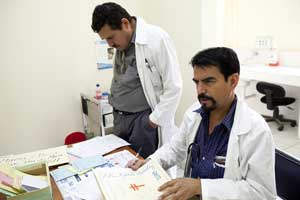Participatory planning
 Staff ownership and involvement in decision-making contributes to successful integration (Kennedy et al. 2011). Church and Mayhew (2009, 177) note that “[p]roviders’ and managers’ involvement in planning for integrated care also has been shown to improve providers’ satisfaction with and motivation for offering these services.” Engaging a wide stakeholder base at national, regional, district, and community levels, including organizational leaders, community leaders, and government, during integration program planning and implementation is widely acknowledged to be a crucial step in integrating services (Farrell, Nagendi, and Efem 2011; Gitau et al. 2011; UNAIDS 2010; WHO 2009; United States Government 2012). Involving community members helps them understand the purpose of and access FP/HIV services and serves as motivation for CHWs to maintain positive reputations by providing high-quality services (Extending Service Delivery Project 2011). In planning for integration programs, the Integra Project (Ndwiga, Warren, and Abuya 2011) held advocacy meetings with health managers at all levels to ensure buy-in on areas such as selection criteria for the mentors and mentees; key competencies required for FP/HIV integration; and required training, including HIV testing and counseling and long-term FP methods. In Zimbabwe, regular coordination meetings helped facility-based providers have ownership of integration and work more effectively with CHWs (Extending Service Delivery Project 2011). As the international development, public health, and evaluation communities have learned, participation is critical to sustainability of projects and project benefits. Stakeholders—including formal and community health workers—need to be involved from the beginning so that they are invested in the success of integrated FP/HIV services.
Staff ownership and involvement in decision-making contributes to successful integration (Kennedy et al. 2011). Church and Mayhew (2009, 177) note that “[p]roviders’ and managers’ involvement in planning for integrated care also has been shown to improve providers’ satisfaction with and motivation for offering these services.” Engaging a wide stakeholder base at national, regional, district, and community levels, including organizational leaders, community leaders, and government, during integration program planning and implementation is widely acknowledged to be a crucial step in integrating services (Farrell, Nagendi, and Efem 2011; Gitau et al. 2011; UNAIDS 2010; WHO 2009; United States Government 2012). Involving community members helps them understand the purpose of and access FP/HIV services and serves as motivation for CHWs to maintain positive reputations by providing high-quality services (Extending Service Delivery Project 2011). In planning for integration programs, the Integra Project (Ndwiga, Warren, and Abuya 2011) held advocacy meetings with health managers at all levels to ensure buy-in on areas such as selection criteria for the mentors and mentees; key competencies required for FP/HIV integration; and required training, including HIV testing and counseling and long-term FP methods. In Zimbabwe, regular coordination meetings helped facility-based providers have ownership of integration and work more effectively with CHWs (Extending Service Delivery Project 2011). As the international development, public health, and evaluation communities have learned, participation is critical to sustainability of projects and project benefits. Stakeholders—including formal and community health workers—need to be involved from the beginning so that they are invested in the success of integrated FP/HIV services.

